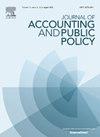为不法行为负责。银行不当行为的财务后果
IF 2.2
3区 管理学
Q1 BUSINESS, FINANCE
引用次数: 0
摘要
本文研究了影响银行披露不当行为相关费用的决定因素,并评估了这些不当行为相关费用对未来不当行为处罚公告的预测程度。以前的研究主要集中在处罚公告上,将其作为银行不当行为财务后果的主要指标。然而,不当行为对P&;L的影响受到会计规则的影响,这些规则促使银行在宣布未来的处罚之前披露拨备或成本。通过对全球系统重要性银行手工收集的数据样本,我们确定不当行为准备金的披露主要由会计准则决定。我们还证明,不当行为条款是在宣布处罚之前累积的,并提供了即将到来的处罚金额的预先指示。虽然不当行为规定(如果有的话)可以被认为是衡量不当行为的最佳标准,但经验证据表明,这些规定的披露是有限的。另一方面,银行经常在季度财务文件中公布与不当行为相关的损益成本。这些披露在不同的会计准则中是频繁、全面和普遍的,预期的罚款规模是其披露的主要决定因素。不当行为成本条款也具有前瞻性。这意味着,当P&;L不当行为相关的成本被披露时,市场会做出相应的反应,预期未来会受到惩罚。我们的研究首次分析了银行不当行为的会计要素、不当行为披露与处罚公告之间的相互作用以及这些披露对股票收益的影响。本文章由计算机程序翻译,如有差异,请以英文原文为准。
Accounting for wrongdoing. The financial consequences of bank misconduct
This paper investigates the determinants influencing banks’ decisions to disclose P&L misconduct-related charges and assesses the extent to which these P&L charges can predict future misconduct penalty announcements. Previous research has largely focused on the penalty announcements as the primary indicator for the financial consequences of bank misconduct. However, the P&L impact of misconduct is influenced by accounting rules that drive banks to disclose a provision or cost ahead of the announcement of a future penalty. Using a sample of hand collected data for Global Systemically Important Banks, we establish that disclosure of misconduct provisions is primarily determined by accounting standards. We also demonstrate that misconduct provisions are accrued prior to a penalty being announced and provide advance indication of the amount of forthcoming penalties. While misconduct provisions, when available, could be considered the optimal measure of misconduct, the empirical evidence shows that their disclosure is limited. On the other hand, banks often make known their misconduct-related P&L costs on their quarterly financial documents. These disclosures are frequent, comprehensive and pervasive across different accounting standards, with expected penalty size as the primary determinant of their disclosure. P&L misconduct costs also share the forward-looking nature of provisions. This implies that, when P&L misconduct related costs are disclosed, markets react accordingly, anticipating a future penalty. Our research provides the first analysis of the accounting elements of bank misconduct, the interaction between misconduct disclosures and penalty announcements and the influence of these disclosures on stock returns.
求助全文
通过发布文献求助,成功后即可免费获取论文全文。
去求助
来源期刊

Journal of Accounting and Public Policy
Multiple-
CiteScore
4.80
自引率
2.80%
发文量
75
期刊介绍:
The Journal of Accounting and Public Policy publishes research papers focusing on the intersection between accounting and public policy. Preference is given to papers illuminating through theoretical or empirical analysis, the effects of accounting on public policy and vice-versa. Subjects treated in this journal include the interface of accounting with economics, political science, sociology, or law. The Journal includes a section entitled Accounting Letters. This section publishes short research articles that should not exceed approximately 3,000 words. The objective of this section is to facilitate the rapid dissemination of important accounting research. Accordingly, articles submitted to this section will be reviewed within fours weeks of receipt, revisions will be limited to one, and publication will occur within four months of acceptance.
 求助内容:
求助内容: 应助结果提醒方式:
应助结果提醒方式:


